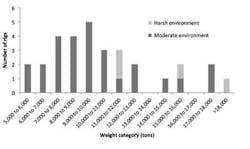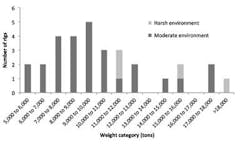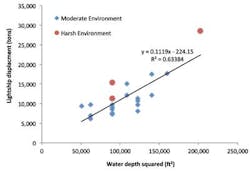New model predicts jackup weight and displacement
Mark J. Kaiser
Brian F. Snyder
Center for Energy Studies
Louisiana State University
The weight of a rig is an important variable in cost estimation and determines the amount of steel required in construction. Rig weight is generally considered proprietary, however, because it indicates design benchmarks and construction performance metrics that are central to the competitive nature of the industry. Several methods can be used to predict ship weight, but given the structural differences between jackup rigs and ships, these techniques are not adequate to predict rig weight. The purpose of this article is to construct a jackup lightweight displacement function based on empirical analysis of a random sample of rigs.
Weight management
Weight is an important design factor and a primary feature in determining the physical characteristics of a rig. Larger rigs have greater variable loads, can support more powerful drilling equipment, and operate in more severe conditions. Weight is linked to fabrication costs. As more steel is added, material costs and fabrication expenses increase, but complex tradeoffs are involved with weight management, and because so many interdependent factors are involved, it is difficult to quantify the effects of weight on cost. Weight is also a critical factor in determining rig stability and the size and design of spudcans.
Weight factors
The weight of a jackup rig is primarily determined by the water depth, drilling, and environmental capability, and rig design.
Water depth. As the water depth capability of a rig increases, the length of the legs increase. At some point, incremental leg length cannot be added to a given hull design and the hull must be enlarged. As a result, water depth is correlated with a number of physical descriptors including leg length, hull breadth, hull depth, deck area, and hull volume.
Drilling depth. In order to increase the drilling depth capability of a rig, designers make allowances for more powerful drilling equipment, stronger cantilevers, and greater variable loads. Larger and heavier rigs are required to accommodate more numerous and powerful drilling systems and heavier cantilever loads.
Environmental capability. Harsh environment rigs are heavier than moderate environment units. For the same water depth capability, harsh environment rigs must have longer legs than moderate environment units to increase the air gap. The legs and spudcans of harsh environment rigs are built to a more robust standard than moderate environment rigs and use higher quality and thicker steel. Harsh environment units may also have greater variable loads than moderate units to reduce the frequency of resupply, and this requires a larger, heavier rig.
Since jackups are particularly well suited to harsh environment operations, some contractors have built harsh environment jackups with 500-ft (152-m) water depth capabilities to extend the use of jackups into waters typically limited to semis. Ultra-high specification jackups are much heavier than moderate environment units. For example, the Gusto MSC CJ 70 weighs 28,000 tons, approximately twice the weight of a typical moderate environment unit.
Rig design. The tradeoffs designers make between the grade and quantity of steel impact rig weight. Either larger quantities of lower grade steel or smaller quantities of higher grade steel may be employed. For example, a rig designer may increase the number of braces in each leg, but decrease the yield strength of the steel. Using lower grade steel will increase weight, but may result in lower costs.
Rigs may employ rack chocks. Rack chocks are inserted after jacking to transfer the vertical load from the leg racks to the hull. Without rack chocks, the load is held by the pinions in the jacking system. The use of chocks increases the fixity between the hull and the legs, and allows for a reduction in the bracing in the legs to reduce leg weight. Most F&G, Baker Marine, Keppel, and Gusto MSC rigs utilize chocks, while most Letourneau rigs do not.
Data source
Information on rig weights is not widely available and is generally considered proprietary. We assembled data from 31 rigs representing 21 designs and three harsh environment units. Water depth, hull length, hull width, build year, and designer data were collected from the academic and trade literature, specification sheets, and industry personnel. The sample includes most of the rigs commonly built in shipyards, including the F&G L780 Mod II, the LeTourneau Super 116, the Baker Marine 375 and the Gusto CJ 70 X 150. In a few cases, lightweight displacements were estimated as the transit displacement minus the transit variable load to supplement the dataset. When more than one data point was available from a single rig design, the displacements were averaged to ensure that the data points were independent.
Summary statistics
The distribution of lightweight displacement from the rig sample has an average of 11,479 tons (range 5,569-28,600 tons) and an average water depth capability of 314 ft (range 250-450 ft/76-137 m). For harsh and moderate environment rigs, the average displacement was 17,575 and 10,195 tons, respectively. The age distribution was bimodal with 10 of the 31 rigs built after 2008, and 19 of 31 built before 1985. The average age of all the rigs was 22 years.
Single factor models
One key issue is the relationship between displacement and water depth. Water depth explains 57% of the variation in lightweight, but water depth squared turns out to be a slightly better predictor. In a regression analysis, the three harsh environment designs weigh more than average moderate environment rigs for the same water depth capability.
Another key issue is the relationship between hull dimensions and rig weight. Hull dimensions predict about half of the variation in rig weight, but unlike the water depth relationship, there is no trend of harsh environment rigs being heavier than moderate environment rigs for a given hull dimension.
Weight relation
A linear regression model was developed to predict rig weight using hull length and breadth (width), water depth capability, designer, environmental class (harsh versus moderate) and build year as predictor variables. Hull length times hull breadth entered the model as an interaction term to proxy the area of the hull. Designer and environmental class were modeled as indicator variables. Variables were checked for multicolinearity, and because breadth was correlated with length and environmental class, these variables were not permitted to enter the same model.
The best model included terms for water depth, water depth squared, and hull length times hull width:
| D = 49,316 – 3,233WD + 0.563(WD)2 + 0.12LB |
where D is lightship displacement (tons), WD is water depth capability (feet), and L and B are the length (feet) and breadth (feet) of the rig, respectively. Environmental class, designer and build year were not significant predictors.
The model explained 91% of the variations in displacement and all terms were significant. The inclusion of the length and width interaction term explained slightly more variation than either the length or width terms individually, and the coefficients were insignificant when the interaction term and the length or width terms were included together.
Water depth is positively correlated with weight, and as water depth increases, the slope of the relationship increases because of the squared term. In reality, width and breadth are not constant with increasing water depth, but enter the model relative to their physical characteristics.
The harsh environment indicator variable was not a significant predictor of weight. This is likely due to the fact that only three designs were harsh environment units. Data restrictions limit the ability of the model to accurately predict the weight of harsh environment rigs. Build year and designer were also not significant predictors, which could indicate physical similarity in rig designs over time and between designers.
Limitations
Small sample size reduces the confidence in the results and inflates model fit. However, because the total number of rig designs in the world is limited and our sample includes the most popular, the relations are expected to be reasonably robust. Additional predictor variables could be examined in re-specified models, but since the model already predicts over 90% of the variation in weight, the weight relation is considered adequate for aggregate assessments and gross benchmarking studies.
Additional error may be introduced because the lightweight displacement of some vessels was based on estimated values, and a number of different sources were utilized which may estimate lightweight displacement differently. When multiple records for a single rig design were available, the reported weights matched closely, and deficiencies in the weight reporting may be partly offset by the averaging of multiple records.
Editor's note: This article is the second of a five-part series by Mark Kaiser and Brian Snyder on rig construction costs, weight specifications, and market day rates.



